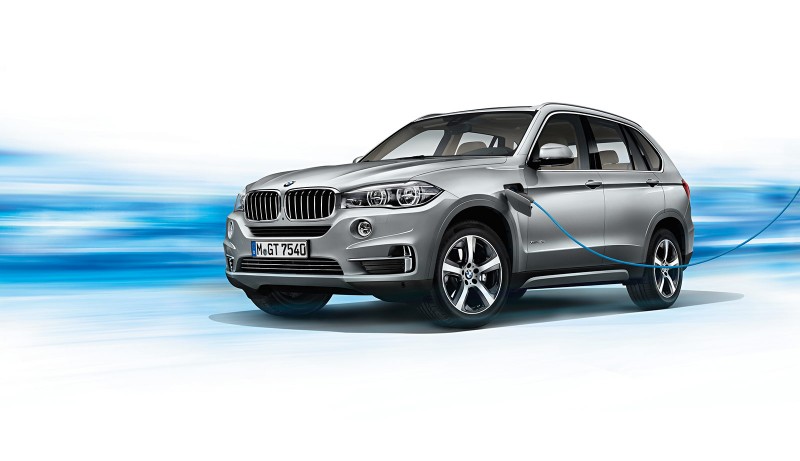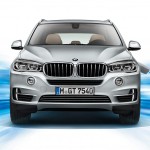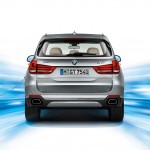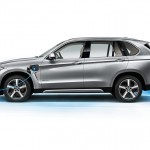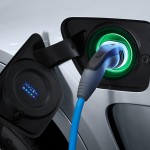Just as reports spread of the new BMW 5-Series sporting two inlets, one for fuel and another for electricity, BMW have officially announced their first plug-in hybrid electric vehicle in their mainstream line-up, the BMW X5 PHEV.
Incomprehensible names are nothing new from car makers and this latest technological beast is no different with its official title being the “BMW X5 xDrive40e”. Naming aside, perhaps of note is BMW’s decision not to put the X5 into its cutting edge BMW i branding. This X5 PHEV then, is the first plug-in hybrid from the core BMW brand.
BMW state the car’s intention is to maintain the luxury and performance of a standard petrol or diesel X5, yet combine it with a xDrive intelligent all-wheel-drive system and BMW’s EfficientDynamics eDrive technology to achieve excellent efficiency – presumably for a car of its class.
On paper at least, the X5 PHEV certainly appears to manage this feat with CO2 emissions as low as 77g/km and a combined official fuel consumption of 85.6mpg. However, as you would expect for a BMW, these figures have not come at the expense of making the car a slow and lumbering technofest. Instead, 0-62mph is blitzed in a rather rapid 6.8 seconds and top speed is a limited 130mph.
Total system power is 313hp, with 245hp being provided by the petrol four-cylinder and the remaining 113hp from the electric motor. Torque is expectedly strong with 450Nm combined total. The two power sources go through an 8-speed Steptronic transmission, meaning the electric motor does not encroach on occupant space since it is integrated into the transmission.
The 2.0 litre petrol unit features a TwinScroll turbocharger, High Precision Injection, variable valve timing and variable camshaft control on both the intake and exhaust sides (Double-VANOS). It is the most powerful four-cylinder petrol unit in BMW Group’s engine portfolio.
The 9Wh battery is lithium-ion and housed beneath the boot floor. It is compromised slightly by this addition, but there are still a healthy 500 -1,720 litres capacity available for luggage, so the dent has been kept to a minimum. Fortunately, unlike the i3, there is a handy stowage compartment destined to be home for charging cables, keeping the boot space itself uncluttered.
BMW reckon on 94.2mpg for short 15 mile journeys, which they say sets a new benchmark in its class. All-electric range is said to be 19 miles, while top speed in EV mode is limited to a usable 75mph. Interestingly, and away from convention, BMW say that for commutes of 37 miles (when starting out with a fully charged battery) fuel consumption will not be lower than 43.5mpg. This figure seems quite conservative and could easily be improved by use of public charge points, which the X5 PHEV can accept. As with all PHEV’s though, there is a cut-off point at which they become more expensive to run than a conventionally powered equivalent vehicle, since the weight offset by carrying around the battery becomes a burden. This appears to be around the 100 mile figure, so for most the PHEV will be the sensible choice if deciding to opt for an X5 at all.
The X5 PHEV is equipped with a plethora of drive options, which essentially boil down to the more usual three options – Auto, EV and Save. The latter is used to store up energy using the petrol engine, for example before heading into a town/city where EV driving is desirable. Coupled with these modes are COMFORT, SPORT and ECO PRO modes which handle throttle response and steering characteristics as well as transmission responsiveness. Dynamic Damper Control is included as standard on the BMW X5 xDrive40e and this too is affected by the different drive modes.
Some drivers may experience a slightly odd sensation, whereby the X5 PHEV shuts off the engine when travelling at speed. Fear not, for this isn’t an error or disaster, but instead the X5’s in-built ability to ‘coast’. The idea is as old as the motor car and even used to be taught as good driving practice – the engine is shut off to conserve fuel, allowing the vehicle to glide along under its own inertia. The system only activates when on overrun, or in other words when the engine isn’t being used. the ‘engine braking’ effect while travelling down a hill might be affected by this, but a test drive will be sought to find out.
Charging the X5 xDrive40e is as simple as plugging into a hole in the wall. A standard three-pin socket should charge the battery in around four hours. BMW’s Wallbox can be installed at a purchasers home and can charge the battery in under three hours (at 3.5kW 16A/230V). A 7kW charge point is likely to reduce this time by half.
Under the umbrella of BMW 360° ELECTRIC, customers are offered an all- embracing service concept covering everything from the supply and installation of the charging station to maintenance, advice and other services. There is also the ChargeNow service, comprising a ChargeNow card that grants straightforward access to partner charging stations and can also be used for convenient billing of the monthly energy costs. The ParkNow Longterm mobility service simplifies the task of finding a parking space in urban centres, and also helps with finding and booking a parking spot with access to charging facilities. Beyond this, the BMW 360° ELECTRIC portfolio also comprises maintenance, assistance and other customer services that have been specially tailored to this model. It would appear that no rapid charging is available, although this might be available as an option.
The BMW X5 xDrive40e is assembled at BMW Spartanburg plant in the US state of South Carolina, in parallel with both the other model variants of the BMW X5 and the BMW X6 on a shared production line. Special assembly steps have been added to the manufacturing process for integrating the hybrid-specific components, and the high-voltage battery is also manufactured on-site.
The BMW X5 xDrive 40e goes on sale Autumn 2015. Prices will be announced at a later date.
Soure; BMW X5
